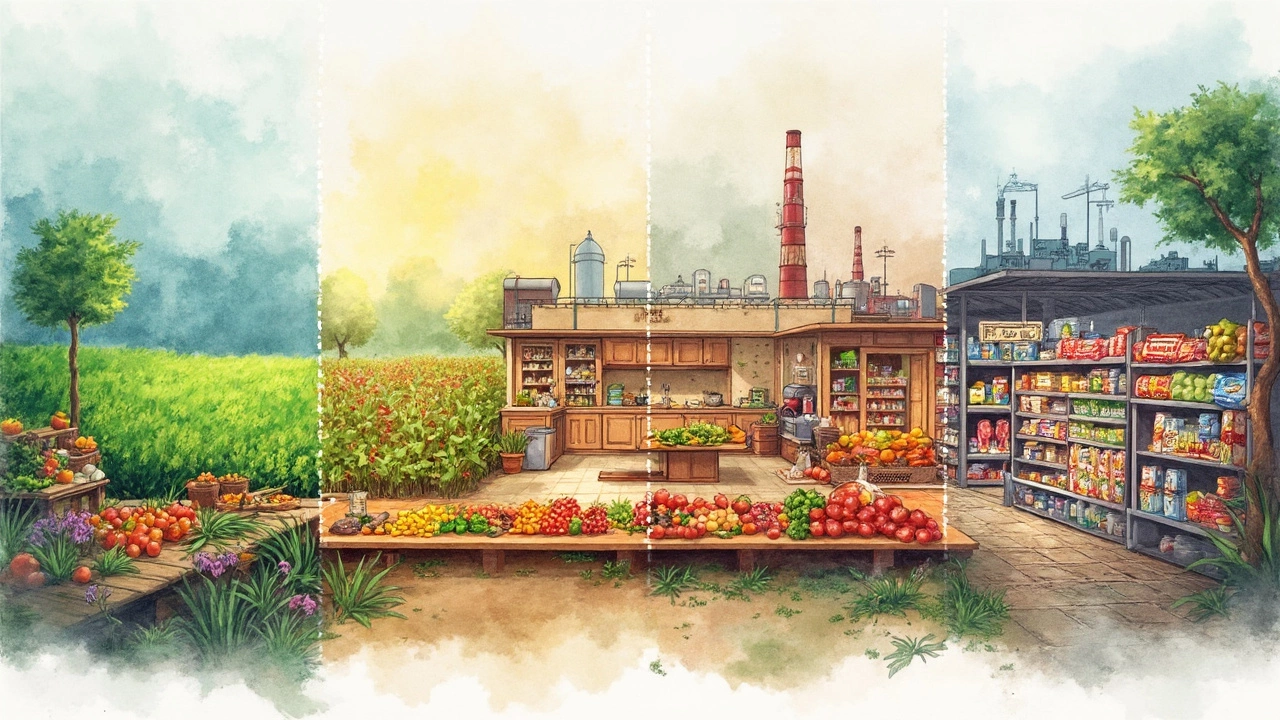
Ever wonder what's happening to your food before it hits your plate? Let's break down the four levels of food processing. It's not just about turning raw ingredients into something we can eat. It's a spectrum that ranges from simple, minimally processed foods to the complex concoctions we sometimes find in our supermarkets.
Understanding these levels isn't just for nutrition buffs. Knowing what goes into your food can guide smarter choices. Whether you're a fan of home-cooked meals or lean towards convenience foods, knowing how these processes affect nutritional value and shelf life is key. So, buckle up for a quick trip through the ins and outs of food processing.
- Raw and Minimally Processed Foods
- Processed Culinary Ingredients
- Processed Foods
- Ultra-Processed Food Products
Raw and Minimally Processed Foods
Okay, so let's start with the basics: raw and minimally processed foods. This is the category where we're talking about things that look pretty much like how they did when they were harvested. Think fresh fruits and veggies, nuts, milk straight from the cow (after a quick pasteurization, of course), or even freshly caught fish. These foods have had minimal alterations beyond cleaning, maybe a little peeling, or slicing.
Why do these foods matter? Well, they're generally packed with nutrients and haven't lost much through processing. Fresh produce, for instance, is loaded with vitamins and minerals right from Mother Nature's pantry. Making them a part of your diet can not only offer nutritional benefits but improve overall health.
Here's an interesting fact: unprocessed foods like whole fruits and vegetables usually contain more fiber compared to processed options. Fiber is super important, not only for keeping your digestive system happy but also for reducing risks of chronic diseases. A study found that increasing fiber intake can help in managing weight and even lowering cholesterol levels.
Eating raw and minimally processed foods often means easy prep in the kitchen, too. For an effortless snack, try reaching for an apple or a handful of almonds. Meals can be as simple as a salad with a variety of your favorite veggies topped with olive oil and lemon juice (yes, those ingredients are also minimally processed!).
But keep in mind, since these foods are less processed, they may spoil faster. That's where preservation methods like refrigeration come into play. Just be sure to enjoy them before they lose their freshness!
Processed Culinary Ingredients
When it comes to the world of food processing, processed culinary ingredients are a fascinating bunch. Think of them as the magic wands in your kitchen—helping transform basic ingredients into delicious meals. These are not the meals themselves but are items like oils, sugars, and flours that make the cooking process smoother.
Imagine you're baking cookies. You need flour, sugar, and maybe some oil or butter. These ingredients are the middlemen between raw foods and fully prepared dishes. While they might get a bad rap sometimes, they serve an essential purpose. For instance, olive oil doesn't grow on trees—it’s extracted from olives through pressing, refining, and filtering processes. Other examples include corn syrup, which starts its journey as humble corn, and salt, derived from either salt mines or seawater evaporation.
But why should you care about them? Well, knowing which ingredients are processed can be part of making informed food choices. These ingredients usually undergo processes to enhance flavor, longevity, or cost-effectiveness, and understanding these changes can influence what ends up in your shopping cart.
For those watching their food intake, it’s crucial to note that while processed culinary ingredients can save time, some like refined sugars and oils, when overused, can lead to health issues. The key is balance—measuring how much you use in daily cooking can make a huge difference.
Here's a quick look at some common processed culinary ingredients:
- Vegetable Oils: Widely used for frying or baking, extracted through pressing and/or chemical solvents.
- Refined Sugars: Used in sweetening foods, can lead to an energy spike, and should be consumed in moderation.
- Flour: Essential for baking, made by grinding grains like wheat, it can also come fortified with nutrients.
These ingredients help us connect raw products to finished meals, making them quite handy. Whether you're whipping up a pancake batch or sautéing veggies, having a good stash of these in your kitchen is like keeping your toolkit well-stocked.

Processed Foods
Alright, let’s dig into the world of processed foods. These are foods that have been altered from their original state for flavor, convenience, or preservation. We’re talking about things like canned veggies, cheese, bread, and even some wines.
The main goal here is to make food last longer or taste better. This often involves techniques like canning, freezing, and even adding mixes of ingredients. But putting it simply, a lot of what we buy at the grocery store falls into this category. This isn't necessarily bad—think about canned tomatoes or frozen peas—they're filling gaps in our pantries when fresh isn’t an option.
The food industry relies on processing to ensure we have access to a wide array of options, regardless of the season. However, it’s essential to pay attention to labels. Some processed foods sneak in extra sugar, salt, or fat.
Here’s a quick tip: if you can't pronounce more than a few ingredients on the label, maybe reconsider. It's easy to lose track of what's really in there, and that's when things move towards the next level—ultra-processed food products, which often mean less healthy for you.
Processed foods do serve a practical purpose, so don't be too quick to shun them. It's about picking the ones that best fit your health goals and making sure you balance them with fresh options wherever you can.
Ultra-Processed Food Products
Welcome to the land of ultra-processed food products, where food has been through so much, it barely resembles its original form. These are the snack bars, sodas, instant noodles, and many frozen meals that pack supermarket shelves. They've got long ingredient lists full of stuff you'd need a chemistry degree to pronounce, and they're a big part of the modern diet.
Ultra-processed foods often come with lots of added sugars, fats, colorings, and preservatives. They're designed to be tasty, convenient, and have a long shelf life, but that convenience comes at a cost. These foods tend to be higher in calories and lower in nutrients than their less-processed counterparts. For example, a can of soda, which is highly processed, offers quick energy due to high sugar but lacks essential vitamins and minerals found in natural fruit juices.
Here's something to chew on: a study found that diets high in these foods are linked to obesity and other health issues, possibly because they're designed to be hyper-palatable. Our brains love the speed and the hit of pleasure these foods provide, making it easy to overconsume.
So, how can you tell if you're dealing with an ultra-processed food? Look out for these signs:
- Long ingredient lists with unfamiliar names
- High amounts of added sugars and fats
- Bright colors or artificial flavorings
- Items that you're not likely to make at home
Being aware of food processing levels can help you make better food choices. Not saying you should cut them out entirely, but knowing when and how to enjoy them can make all the difference. Keep it balanced, and don't let ultra-processed foods take over your diet completely.

